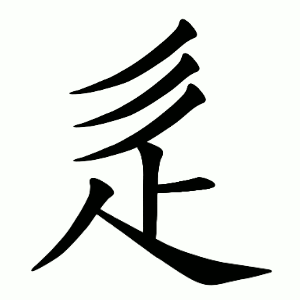辵
- to walk slowly, to go slowly;
Usage in Korean
辵 is a rarely used, obscure character (벽자, 僻字) that most people never use in daily life. However, this character is very important because it is the base radical of the "radical on the side" form called 책받침 (⻍).
Characters that use the 책받침/착받침 radical generally have meanings related to:
1. walking or movement
2. traveling or going
3. foot traffic or passage
4. transport or communication
5. physics-related elements
Examples:
道 (길 도) — road, way
通 (통할 통) — to pass, to communicate
進 (나아갈 진) — to advance
過 (지날 과) — to pass
近 (가까울 근) — near
遠 (멀 원) — far
逆 (거스를 역) — to go against
速 (빠를 속) — fast
遲 (더딜 지) — slow
追 (쫓을 추) — to chase
送 (보낼 송) — to send
運 (옮길 운) — to transport
逃 (달아날 도) — to escape
迎 (맞을 영) — to welcome
Alternative forms
Characters with 辵
7 strokes
8 strokes
9 strokes
- 迦–Buddha’s name Ga
- 迫–to press, to compel, to urge, to oppress
- 迭–to alternate, to take turns
- 述–to state, to narrate, to describe, to follow, to pursue, to extend, to carry out
- 迷–to be lost, to go astray, to be confused
- 退–to retreat, to withdraw, to step back, to dismiss
- 送–to send, to deliver, to dispatch
- 逆–to go against, to oppose, to resist, to go contrary to
10 strokes
11 strokes
12 strokes
13 strokes
- 遂–finally, at last, to advance, to accomplish/achieve, to escape, to recommend, to raise/nurture, to follow, to hesitate, road, path
- 遇–to meet, to encounter, to face
- 運–to carry, to move, fortune, luck
- 遍–widely, everywhere, pervasively, a round, a turn, a time
- 道–road, path, way, method, doctrine, principle, to lead, to guide
16 strokes
17 strokes
19 strokes
58 strokes
辵
쉬엄쉬엄갈
착
swieomswieomgal
chak
Kangxi radical:162
Strokes:7
Unicode:U+8FB5
Cangjie input:
- 竹竹竹人 (HHHO)
Composition:
- ⿱ 彡 龰
